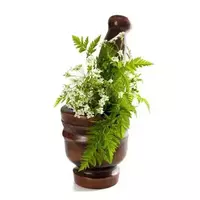Diaghil

Diagille is a rather tall plant (up to two meters), which is distinguished by a large umbrella with small yellowish-greenish or white flowers and carved leaves. The plant is characterized by a powerful root system and a strong aroma - these are the properties of the diagline and are especially relevant for cooking.
As a spice, as a rule, the diagline root is used, which is impressive in size - it is fleshy and thick, with snow-white pulp. The most strong, well-expressed pleasant aroma is possessed by the root of a biennial plant, while the roots of a younger diaglium exude a faint tender smell. By the way, the rhizome, shoots and seeds of the angelica almost do not give out an odor. It is customary to collect young angelica shoots exclusively in May, roots in early spring or autumn, and seeds in August-September.
For culinary purposes, the roots of the diagline are first removed from rough skin, and then added to hot dishes, vegetable salads or soups to flavour meals. Fresh roots are often crushed, poured with sugar syrup, boiled - it turns out a rather peculiar jam. In addition, fragrant candied fruits can be made from the diagline root.
The powder made from dry roots can be added to pastries, soups in meat or vegetable broth, as well as fried meat. As a rule, this spice is added to hot dishes a couple of minutes before the end of cooking. Diaghil seeds are mainly used to flavour home-made vodka. By the way, it is believed that the most delicious pickled or spicy herring is made precisely with the addition of a powdered diagline root, as well as a small amount of seeds.
Diaghil shoots in some Western countries - Norway, Sweden and Iceland - are considered the best vegetable dish. Stems and leaves are often fried, boiled and consumed as a side dish, and in fresh are added to a variety of salads. Interestingly, in France, it is customary to make tinctures and liqueurs based on the juice of Diagille. In addition, the dried root of the plant produces fragrant and unusually healthy tea.
The useful properties of the diagline are due to the content of a considerable amount of valuable substances, in connection with which it is often called a plant that gives strength. The roots and other parts of the diagline contain resins, essential oils, apple, acetic, angelic, valerian and other acids, as well as pectin and tannins. For example, the essential oil, which is made of diagyl, includes fatty oils, proteins, protein, fiber, fats, calcium, ascorbic acid and phosphorus. That is why since ancient times, Diaghil has been considered a valuable medicinal plant that strengthens the heart, stimulates blood circulation and positively affects immunity.
10 kCal diagline
The energy value of Diaghil (Ratio of proteins, fats, carbohydrates - ju):
Proteins: 0.1 g (~ 0 kCal)
Fats: 0 g (~ 0 kCal)
Carbohydrates: 2g (~ 8kCal)
Energy ratio (b | y): 4% | 0% | 80%
 Español
Español Français
Français Português
Português Русский
Русский 简体中文
简体中文 繁體中文
繁體中文 日本語
日本語 한국어
한국어 العربية
العربية Türkçe
Türkçe Қазақ
Қазақ Deutsch
Deutsch Italiano
Italiano Українська
Українська
